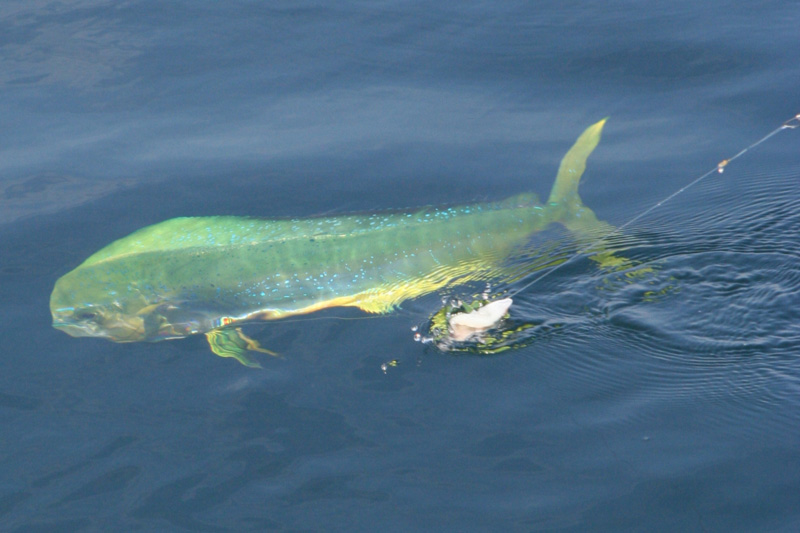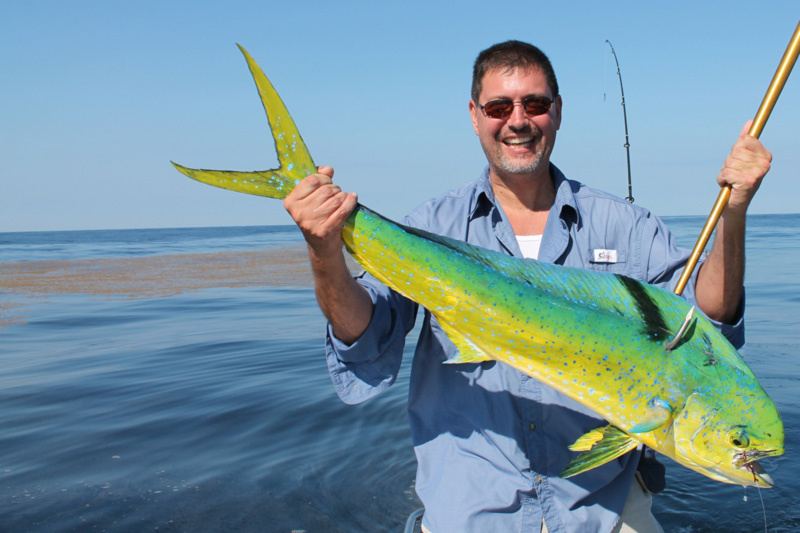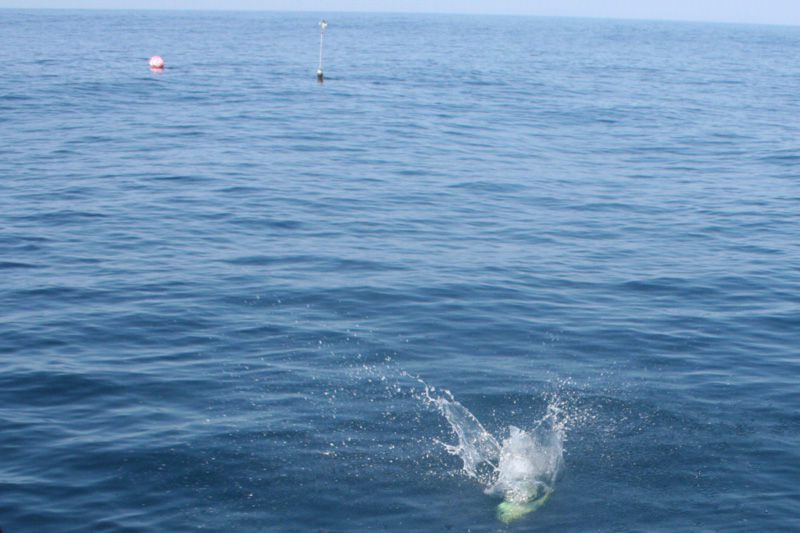Mahi-mahi seem like they always want to eat everything and anything they can wrap their jaws around — until they don’t. Anyone who spends a significant amount of time bailing for them around commercial fishing floats, weed paddies, or flotsam can confirm that sooner or later you’ll spot a perfectly normal looking school of fish that, for whatever reason, turns up their noses at your offerings. What to do? Employ some advanced bailing tactics that will help you get those finicky fish on the line.

- Get Stealthy – While mahi often seem like they couldn’t care less about the presence of a boat, at other times, that big chunk of fiberglass does spook ‘em. Step number one is to reduce the volume, and eliminate noises like slamming hatches, loud voices, and sliding tackleboxes. Also, time your approach to drift into casting position without shifting the engines into reverse. The metal-on-metal clank of a transmission shifting into reverse will often scare the fish and trigger a hunger strike. This is particularly true for outboards that don’t have a hub-dampening system.
- Get Live – Eighty or 90 percent of the time, mahi are more than happy to chomp on chunks of cut bait. On those occasions when they get selective, however, they’ll still have a very tough time turning away from virtually any type of live bait. And live-bait chumming will send a school of docile mahi into a full-blown frenzy. Carry a bucket full of bull minnow with you when you run offshore, and when you spot mahi that won’t eat, grab a handful of minnow and throw them so they bounce off your transom or outboard cowl and into the water. The stunned minnow will swim in tight, frantic circles that will trigger a mahinuclear reaction.
- Get Light – Just like tuna, there will be occasions where you can watch the fish swim up to a bait on 40-pound fluorocarbon leader only to turn away at the last moment. But if you drop to 30-pound test, those very same fish will sometimes eat with abandon. Note: if you use this tactic, be absolutely sure to use circle hooks. If you don’t hook the mahi right in the corner of the mouth they’ll chafe the leader in no time, and large fish that you can’t horse in are likely to break off before you get them within gaffing range.
- Get Squid – Whole squid, that is. When mahi reject chunks, a whole squid with the hook hidden in its mantle will often tempt them into biting. The trick is to hide the hook thoroughly (slide it into the tip of the mantle, thread it down the shank, and then pop the tip through just past the barb) and then let the squid free-fall after you cast it out near the fish and/or flotsam. As the squid sinks, its tentacles will wiggle and waggle in an irresistible manner that usually generates aggression from the predators.
- Get Going – Sometimes you’ll visit several different floats and see fish at some or all of them, but no matter what you try they remain lockjawed. When mahi are acting this way, it’s best to stay on the move rather than sitting on a school and trying in vain to trigger a response. Sometimes you can hit five or even 10 floats with the same result, but when you get to float number 11 the fish are in a completely different mood.
Okay: all of those tips will help you get the fish biting when they’re in lockjaw-mode. But since we’re getting into advanced tactics here, there are a few specific situations that we also need to address.
Fishing Weedlines
Weedlines can prove particularly frustrating, because when you find one you’ll often have miles of it to work with. Or possibly, there will be bunches of scattered weeds in all directions. In either case, figuring out where to stop and bail is problematic. But those weeds have a few significant tells that may give away the location of the fish.
First, look for anything unusual trapped inside the weeds. A stick or board, a large piece of plastic, a dead fish or turtle, or anything else in addition to the weeds themselves. And you never know what you’ll see floating around out there — my best find ever was a full-sized upright refrigerator, which supported an entire ecosystem including mahi upwards of 30-pounds. But at the opposite end of the spectrum, I’ve also found schools of fish concentrated by items as small as a broomstick. The size of the item isn’t as important as the fact that there’s just something different or unusual present.

Second, look for tighter concentrations of weed. If there are scattered patches the size of a Frisbee as far as the eye can see, but one patch the size of a car, you can bet money that any mahi in the area will be clustered around that one big patch.
Finally, when you have a long concentrated weedline that stretches on and on but doesn’t have any irregularities you can spot, switch over to trolling. Deploy small, mahi-friendly offerings like four- or five-inch pink squid or dink ballyhoo, and keep your bucket of cut fish chunks handy. The moment a rod goes down, send a handful of chunks over the side. As you bring in the fish toss more chunks every minute or two. There’s a good chance the hooked mahi will bring his friends right up to the boat with him, and they’ll go bonkers when they see your buffet. Then you can bait up the bailing rods and get to business.
Fishing Around Floats and Flotsam
Floats are probably the most common item to bail around, simply because they’re the ones you can most reliably find out along the canyon edges. But all floats are not created equal. Perfectly clean ones tend to hold fish less often than dirty floats. (Note to commercial fishermen: would y’all please stop cleaning the floats and let ‘em grow a beard?!) Floats with “high fliers” (radar reflectors) also seem to hold fish more often, even though that part of the gear remains out of the water. Also pay special attention to any floats that have weeds or garbage tangled around their lines. As with the weedlines, any irregularity is likely to attract fish.

Flotsam is often the best find of all, since it often doesn’t have competing structure around it. As with the floats, dirty, fouled flotsam with weeds or barnacles growing on it tends to be a better bet than fresh stuff. And as one might guess, the bigger an item is, the better. That said, it’s amazing how small an object can have fish under it. There’s some flotsam, however, that should be ignored. Balloons, floating bottles, and cardboard box tops (often tossed over by chunkers who opened a new flat, unfortunately) are commonly dead ends. That’s not to say you’ll never find a fish under them, but your chances go way down and in the vast majority of the cases, it’s not worth taking the time to stop for items like this. My personal rule: never stop for anything smaller than a five-gallon bucket, and never pass up anything that big without doing at least a brief check.
Catching HUGE Mahi
As an advanced bailer, you say you want to look for king-sized bulls and mega-cow mahi? Rig a jigging rod (like a Shimano Trevala) with a flashy six- to 10-ounce jigging spoon (such as a Nomad Streaker), and assign one angler in the crew to the task of working this rod. That angler should position his or herself on the up-current side of the boat, far enough forward in the cockpit that they won’t get in the way of the anglers who are bailing. Every time you arrive at a float, weeds, or flotsam and toss out your chunks, this angler should drop the jig straight down and allow it to free-fall until it’s at least 125 or 150 feet down. Then, they crank it back up to the surface as fast as they can reel.
It’s rare that this jig will take a strike. However, fish that are much larger than average often stay down deep below the main school and will follow the jig up to the surface out of curiosity. Then they’ll see the feeding frenzy taking place and join in the fun.
You may go for multiple attempts or even multiple trips without a big fish appearing, and feel tempted to hang the jig rod up. But sooner or later you’ll discover that when a big one is down there, this tactic is the best way to bring it within shooting distance. When you do see a big one follow the jig up, the smart move is to immediately clear any light spinning rods you may be using for bailing, which the monster mahi will make mincemeat out of. Reach for a 30-pound class or heavier rod with 60- to 80-pound leader (which you should always have rigged and ready just in case), bait it up with a large offering like a whole ballyhoo or butterfish, and feed the beast.
One note of caution: when bailing for dolphinfish, be careful not to overload the boat. A crew that functions as a finely tuned bailing machine can catch dozens of fish in a matter of minutes when they’re feeling cooperative, and it’s easy to look around after the cockpit chaos and realize you’ve taken an unreasonable number of fish. While it’s true that mahi are the fastest growing fish in the sea (at just three to five months old they’re over five pounds and fully mature and a one-year-old fish commonly exceeds 20 pounds), overharvest leads to waste and that’s something all responsible anglers want to avoid. So keep count as you load the fishbox, and there will be plenty of bailing action next time, too.